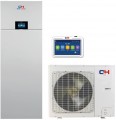In box
—
Indoor unit (hydromodule). The part of a heat pump that is installed indoors. By definition, it is included in the delivery set of "ground-water" units (see "Heat source") — the indoor unit, in this case, is the actual heat pump, only the collector and connecting pipes are brought out. But air models may not have this module.
—
Outdoor unit. It is not used in ground-to-water models. However, it is an almost obligatory element of a complete set for air-to-water units. Usually, the outdoor unit also includes a collector for heat extraction. However, there are air heat pumps that can be installed indoors, with air supply and exhaust through ventilation ducts. — however, for such models, only the indoor unit is indicated in the package, although the device can usually be installed outdoors. And there are even
monoblock models that combine an indoor and outdoor unit in one case.
—
Water heater. A device for heating water and supplying it to the DHW system; see "Water heater" for details. The presence of a built-in water heater, on the one hand, simplifies the installation of the pump and eliminates the need to purchase additional equipment; on the other hand, when buying such a pump, you have to rely on the choice of the manufacturer, while an external water heater can be purchased separately.
Power source
Type of power supply used by the heat pump.
-
Single-phase (230 V). Many models with such a power supply can operate from a conventional outlet, which makes it much easier to connect. However, high power consumption (3.5 kW and above) requires connection to the mains via a distribution board .
-
Three-phase (400 V). Power supply from 400 V mains is suitable for heat pumps of any power, including for models equipped with high-consumption heating elements. In addition, devices with such a supply during continuous operation consume less energy than single-phase devices of similar power consumption. Thus, this option can be envisaged even in heat pumps of low power. The disadvantage of three-phase mains is the necessity to ask for the help of a professional electrician to connect the unit.
Water heater
It is the type of water heater that the heat pump with DHW function is equipped with (see "Suitable for"). All such water heaters usually work on a storage basis — that is, they have a tank where a supply of domestic hot water is stored. The difference is the location of the tank and the principles of water heating.
— Built-in. The water heater installed directly in the heat pump body. This design makes the DHW system less cumbersome (although it increases the dimensions of the pump itself), and allows you to use not only the principle of indirect heating (when heat is transferred to water from the heat exchanger) but also a heating element (if any, see above).
— External. Water heaters installed outside the heat pump body. Unlike built-in ones, they can only work on the principle of indirect heating, which is why they are generally somewhat less efficient. At the same time, the removal of additional equipment outside the housing reduces the dimensions of the pump, and the ability to independently choose a place for installing a water heater is often important.
Water heater volume
It is the volume of the storage tank of the water heater built-in in the heat pump. The larger this volume, the more hot water can be stored in the device and the less the risk of using it up during intensive consumption. Formulas allow you to calculate the optimal volume of the water heater, depending on the specific situation; they can be found in special sources.
COP
The COP (coefficient of performance) is a key characteristic that describes the overall efficiency of a heat pump. It represents the ratio between the thermal power and power consumption of the unit (see above) – in other words, how many kilowatts of thermal energy the pump produces per 1 kW of electricity consumed. In modern heat pumps, this figure can exceed 5.
However, note that the actual COP value may vary depending on the outside temperature and the supply temperature. The higher the difference between these temperatures, the more resources are needed to “pump” thermal energy and the lower the COP will be. Therefore, in the specifications it is customary to indicate the COP value for specific temperatures (and in many models – two values, for different options) – this allows you to evaluate the actual capabilities of the unit.
t°C outside
Outside temperature for which an additional COP is given. See below for details on this coefficient and the value of the outdoor temperature.
Supply t°C
Temperature in the flow pipe for which an additional COP is specified. See below for more details on this coefficient. And this temperature is the temperature of the heat carrier at the outlet of the pump, at which the given COP value is reached.
Note that manufacturers often go to the trick and measure COP for a relatively low temperature (much lower than the maximum temperature of the heat carrier — for example, 35 °C for a model with a maximum of 55 °C). This allows them to give quite impressive performance figures in the specifications. However, at higher temperatures, the actual energy cost per unit of thermal power will be greater and the actual COP will be lower.
COP
Additional heat coefficient COP specified in the specifications in addition to the main one. For more information about the meaning of this indicator, see the "COP" above. And an additional coefficient is indicated for operating temperatures other than the main one — this allows you to evaluate the capabilities of the pump in different conditions.

